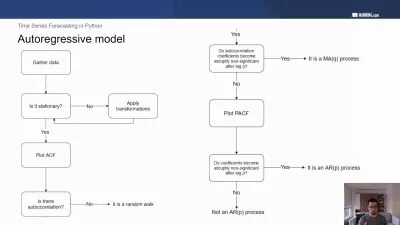Time Series Analysis and Forecasting Using Python
Sathish Jayaraman
2:08:57
Description
ARIMA,Neural Prophet,LightGBM, Random Forest,Pandas,Lag-Llama,Conformal Predictions, Change points, Trend, Seasonality,
What You'll Learn?
- Time Series Data Fundamentals : Reading and Importing Time Series Data, Exponential Smoothing
- Exploratory Data Analysis with Time Series Data (Interactive Visualization of Time-Series Data)
- Decomposition of Time Series Data into Trend, Seasonality Effects, Effect of change points
- Detecting Stationarity in Time Series Data, Auto-Correlation Effects (ACF and PACF Plots)
- Time Series Forecasting using Neural Prophet
- Univariate Time Series Forecasting - ARIMA
- Tree Based Time Series Forecasting - LightGBM
- Fundamentals of Conformal Predictions in Time Series Forecasting (Random Forest, EnbPI)
- Lag-Llama For Time Series Forecasting
Who is this for?
What You Need to Know?
More details
DescriptionThis course delves into the fundamental aspects of time series analysis and forecasting. This course has subsections on exploratory data analysis, decomposition of a time series into trend and seasonality components, neural prophet model, ARIMA, time series forecasting using supervised machine learning (tree-based model), fundamentals of conformal predictions and Lag-Llama model for zero shot learning to make forecast predictions.
The first segment (section 2) covers the definition of time series, importing and reading time series data using SQL Alchemy and Pandas, converting from long-form to wide-form time series data, DarTS time series class and a basic example of exponential smoothing using DarTS.
The second segment (section 3) explains the structure of time series - trend, seasonality components and change points, investigating scenarios related to trend, seasonality, auto-regressive effects and change points using the Neural Prophet Model to make forecast predictions with detailed references for further reading.
The third segment (Section 4) delves into ARIMA model, analysis of stationarity effects using ADF test, Auto-Correlation and Partial Auto-Correlation function in Time Series and Akaike Information Criterion to select ARIMA model parameters for making forecast predictions.
The fourth segment (Section 5) covers time series analysis and forecasting using supervised machine learning, creation of lagged features for a time series forecasting model and the use of Light Gradient Boosting Machine (Light GBM) for time series analysis and forecasting.
The subsequent segment (Section 6) covers the fundamentals of conformal predictions in time series forecasting, defining exchangeability hypothesis, EnbPI algorithm as a conformal predictions framework together with random forest regressor and calculation of coverage score.
The segment six (section 7) covers Lag-Llama which is an open source foundational model for time series forecasting.
Each segment has a google colab notebook associated with it.
Who this course is for:
- This course is suited for anyone interested in delving into the realm of Time Series Analysis and Forecasting.
This course delves into the fundamental aspects of time series analysis and forecasting. This course has subsections on exploratory data analysis, decomposition of a time series into trend and seasonality components, neural prophet model, ARIMA, time series forecasting using supervised machine learning (tree-based model), fundamentals of conformal predictions and Lag-Llama model for zero shot learning to make forecast predictions.
The first segment (section 2) covers the definition of time series, importing and reading time series data using SQL Alchemy and Pandas, converting from long-form to wide-form time series data, DarTS time series class and a basic example of exponential smoothing using DarTS.
The second segment (section 3) explains the structure of time series - trend, seasonality components and change points, investigating scenarios related to trend, seasonality, auto-regressive effects and change points using the Neural Prophet Model to make forecast predictions with detailed references for further reading.
The third segment (Section 4) delves into ARIMA model, analysis of stationarity effects using ADF test, Auto-Correlation and Partial Auto-Correlation function in Time Series and Akaike Information Criterion to select ARIMA model parameters for making forecast predictions.
The fourth segment (Section 5) covers time series analysis and forecasting using supervised machine learning, creation of lagged features for a time series forecasting model and the use of Light Gradient Boosting Machine (Light GBM) for time series analysis and forecasting.
The subsequent segment (Section 6) covers the fundamentals of conformal predictions in time series forecasting, defining exchangeability hypothesis, EnbPI algorithm as a conformal predictions framework together with random forest regressor and calculation of coverage score.
The segment six (section 7) covers Lag-Llama which is an open source foundational model for time series forecasting.
Each segment has a google colab notebook associated with it.
Who this course is for:
- This course is suited for anyone interested in delving into the realm of Time Series Analysis and Forecasting.
User Reviews
Rating
Sathish Jayaraman
Instructor's Courses
Udemy
View courses Udemy- language english
- Training sessions 27
- duration 2:08:57
- Release Date 2024/09/18














